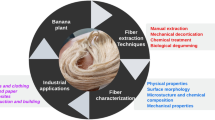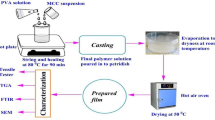Abstract
Mechanical activation is a simple, fast, cost-effective green technology that has been used for the upgrading and modification of microcrystalline cellulose (MCC). However, there is no information on the effect of short-term grinding on its physicochemical properties, as it is widely used for obtaining MCC powder or smaller particle with a size below 50 µm. Thus, the aim of our work was the investigation of physico-chemical properties of the flax unground and short-term ground MCC. In that study MCC was derived from air-dry flax in the medium ‘‘acetic acid–hydrogen peroxide–water’’ in the presence of 2 wt% sulfuric acid catalyst and then in the dry state it was ground in the laboratory mill for 1, 2 and 5 min. The morphology and composition of mechanically unground and ground MCC samples were analysed by different methods: XRD, XRF, FTIR-ATR, AFM, TGA and DSC. According to the XRD patterns of MCC samples, mechanical activation did not change the crystalline form of cellulose, but obviously, it destroyed the crystal structure of ground MCC, resulting in the increase of amorphization and the decrease of crystallinity index (from 86.2 to 78.2%). The FT-IR spectra also showed that the band corresponded to symmetric CH2 bendings at 1435–1429 cm−1, known as the crystallinity band, decreased with MCC samples grinding. AFM indicated that relief of the surface of original MCC changed by mechanical grinding (from the relief with large and small aggregates to the relief consisted of long-chain cellulose molecules parallel layers).









Similar content being viewed by others
References
Autlov SA, Bazarnova NH, Kushnyr EYu (2013) Microcrystalline cellulose. Structure, properties and applications (review). Chem Plant Raw Mater 3:33–41. https://doi.org/10.14258/jcprm.1303033
Baker AA, Helbert W, Sugiyama J, Miles MJ (1997) High-resolution atomic force microscopy of native valonia cellulose I microcrystals. J Struct Biol 119(2):129–138. https://doi.org/10.1006/jsbi.1997.3866
Baker AA, Helbert W, Sugiyama J, Miles MJ (2000) New insight into cellulose structure by atomic force microscopy shows the Ia crystal phase at near-atomic resolution. Biophys J 79(2):1139–1145. https://doi.org/10.1016/S0006-3495(00)76367-3
Barbash VA, Yaschenko OV, Shniruk OM (2017) Preparation and properties of nanocellulose from organosolv straw pulp. Nanoscale Res Lett 12:241–248. https://doi.org/10.1186/s11671-017-2001-4
Battista OA, Smith PA (1962) Microcrystalline cellulose. Ind Eng Chem 54(9):20–29. https://doi.org/10.1021/ie50633a003
Cheng K-C, Catchmark JM, Demirci A (2009) Effect of different additives on bacterial cellulose production by Acetobacter xylinum and analysis of material property. Cellulose 16(6):1033–1045. https://doi.org/10.1007/s10570-009-9346-5
Das K, Ray D, Bandyopadhyay NR, Sengupta S (2010) Study of the properties of microcrystalline cellulose particles from different renewable resources by XRD, FTIR, nanoindentation, TGA and SEM. J Polym Environ 18:355–363. https://doi.org/10.1007/s10924-010-0167-2
Duan L, Yu W, Li Z (2017) Analysis of structural changes in jute fibers after peracetic acid treatment. J Eng Fiber Fabr 12(1):33–42. https://doi.org/10.1177/155892501701200104
El-Sakhawy M, Hassan ML (2007) Physical and mechanical properties of microcrystalline cellulose prepared from agricultural residues. Carbohydr Polym 67:1–10. https://doi.org/10.1016/j.carbpol.2006.04.009
Hanani ASN, Zuliahani A, Nawawi WI, Razif N, Rozyanty AR. (2017) The effect of various acids on properties of microcrystalline cellulose (MCC) extracted from rice husk (RH). In: IOP conference series: materials science and engineering, vol 204, p 012025. https://doi.org/10.1088/1757-899X/204/1/012025. Accessed 20 Dec 2020
Hazwan HM, Husin NA, Bello I, Othman N, Bakar MA, Mohamad Haafiz MK (2018) Isolation of microcrystalline cellulose (MCC) from oil palm frond as potential natural filler for PVA-LiClO4 polymer electrolyte. Int J Electrochem Sci 13:3356–3371. https://doi.org/10.20964/2018.04.06
Herawan T, Panjaitan FR, Yamanaka S (2018) Morphological and structural changes in microcrystalline cellulose from OPEFB by mechanical grinding. In: IOP conference series: earth and environmental science, vol 166, p 012001. https://doi.org/10.1088/1755-1315/166/1/012001
Hindi SSZ (2017) Microcrystalline cellulose: the inexhaustible treasure for pharmaceutical industry. Nanosci Nanotechnol Res. 4(1):17–24. https://doi.org/10.12691/nnr-4-1-3
Hu H, Zhang Y, Liu X, Huang Z, Chen Y, Yang M, Qin X, Feng Z (2014) Structural changes and enhanced accessibility of natural cellulose pretreated by mechanical activation. Polym Bull 71:453–464. https://doi.org/10.1007/s00289-013-1070-5
Huang L, Wub Q, Wang Q, Wolcott M (2019) Mechanical activation and characterization of micronized cellulose particles from pulp fiber. Ind Crop Prod 141:111750. https://doi.org/10.1016/j.indcrop.2019.111750
Jia N, Li S-M, Ma M-G, Zhu J-F, Sun R-C (2011) Synthesis and characterization of cellulose-silica composite fiber in ethanol/water mixed solvents. BioRes 6(2):1186–1195
Klemm D, Heublein B, Fink HP, Bohn A (2005) Cellulose: fascinating biopolymer and sustainable raw material. Angew Chem Int Ed 44:3358–3393. https://doi.org/10.1002/anie.200460587
Kuznetsov BN, Tarabanko VE, Kuznetsova SA (2008) New catalytic methods for obtaining cellulose and other chemical products from vegetable biomass. Kinet Catal 49(4):517–526. https://doi.org/10.1134/S0023158408040101
Kuznetsov BN, Chesnokov NV, Garyntseva NV, Yatsenkova OV (2013) Integrated catalytic processing of aspen wood into liquid and solid biofuels. J Siber Fed Univ Chem 3:286–298
Latif MHA, Mahmood YF (2018) Isolation and characterization of microcrystalline cellulose and preparation of nano-crystalline cellulose from tropical water hyacinth. J Pure Appl Sci 31(1):180–188. https://doi.org/10.30526/31.1.1865
Lokshina I, Lugovskoy S, Melisbekova К, Karabaev SO, Gainullina I, Andreeva E (2015) Microcrystalline cellulose: extraction and analysis. In: Proceedings of the fourteenth Israeli–Russian bi-national workshop, Ariel, pp 101–106
Mishra RK, Sabu A, Tiwari SK (2018) Materials chemistry and the futurist eco-friendly applications of nanocellulose: Status and prospect. J Saudi Chem Soc 22:949–978. https://doi.org/10.1016/j.jscs.2018.02.005
Nandi S, Guha P (2018) A review on preparation and properties of cellulose nanocrystal-incorporated natural biopolymer. J Packag Technol Res. https://doi.org/10.1007/s41783-018-0036-3
Obolenskaya AV, Yelnitskaya ZP, Leonovich AA (1991) Laboratory work on the chemistry of wood and cellulose. Ecology, Moscow
Pachuau L, Vanlalfakawma DC, Tripathi SK, Lalhlenmawia H (2014) Muli bamboo (Melocanna baccifera) as a new source of microcrystalline cellulose. J Appl Pharm Sci 4(11):087–094. https://doi.org/10.7324/JAPS.2014.41115
Papkov SP, Kulichikhin VG (1977) Zhidkokristallicheskoye sostoyaniye polimerov. Khimiya, Moscow
Piras CC, Fern´andez-Prieto S, De Borggraeve WM, (2019) Ball milling: a green technology for the preparation and functionalisation of nanocellulose derivatives. Nanoscale Adv 1:937–947. https://doi.org/10.1039/c8na00238j
Swantomo D, Giyatmi G, Adiguno SH, Wongsawaeng D (2017) Preparation of microcrystalline cellulose from waste cotton fabrics using gamma irradiation. Engl J 21(2):173–182. https://doi.org/10.4186/ej.2017.21.2.173
Szczesniak L, Rachocki A, Tritt-Goc J (2008) Glass transition temperature and thermal decomposition of cellulose powder. Cellulose 15:445–451. https://doi.org/10.1007/s10570-007-9192-2
Tigunova OO, Beiko NE, Kamenskyh DS, Tkachenko TV, Yevdokymenko VO, Kashkovskiy VI, Shulga SM (2016) Lignocellulosic biomass after explosive autohydrolysis as substrate for butanol. Biotechnologia Acta 9(4):28–34. https://doi.org/10.15407/biotech9.04.028
Tkachenko TV, Yevdokymenko VA, Kamenskyh DS, Filonenko MM, Molody DV, Povazhny VA, Vakhrin VV, Kashkovsky VI (2018) Preparation of microcrystalline cellulose from different local agriculture residues. In: EastWest Chemistry conference: abstract book (Lviv, Ukraine, October 10–12, 2018). Lviv Polytechnic Publishing House, Lviv, p 138
Trachea D, Hussinb MH, Chuinb CTH, Sabarc S, Fazitad MRN, Taiwod OFA, Hassand TM, Haafiz MKM (2016) Microcrystalline cellulose: Isolation, characterization and bio-composites application. A review. Int J Biol Macromol 93:789–804. https://doi.org/10.1016/j.ijbiomac.2016.09.056
Zhang L, Zhao K, Li H, Zhang T, Liu D, Han Y (2019) Liquid crystal ordering on conjugated polymers film morphology for high performance. Part B: Polym Phys 57(23):1572–1591. https://doi.org/10.1002/polb.24885
Zheng Y, Fu Z, Li D, Wu M (2018) Effects of ball milling processes on the microstructure and rheological properties of microcrystalline cellulose as a sustainable polymer additive. Materials 11(7):1057. https://doi.org/10.3390/ma11071057
Acknowledgements
The catalytic experiments and laboratory installation assembling have been funding by Target Complex Program of Scientific Research of NAS of Ukraine “Biofuels and bioenergy” 2018-2022.
Author information
Authors and Affiliations
Corresponding author
Ethics declarations
Conflict of interest
On behalf of all authors, the corresponding author states that there is no conflict of interest.
Ethical approval
All procedures performed in studies involving human participants were in accordance with the ethical standards of the institutional and/or national research committee and with the 1964 Helsinki Declaration and its later amendments or comparable ethical standards.
Additional information
Publisher's Note
Springer Nature remains neutral with regard to jurisdictional claims in published maps and institutional affiliations.
Rights and permissions
About this article
Cite this article
Tkachenko, T., Sheludko, Y., Yevdokymenko, V. et al. Physico-chemical properties of flax microcrystalline cellulose. Appl Nanosci 12, 1007–1020 (2022). https://doi.org/10.1007/s13204-021-01819-2
Received:
Accepted:
Published:
Issue Date:
DOI: https://doi.org/10.1007/s13204-021-01819-2




